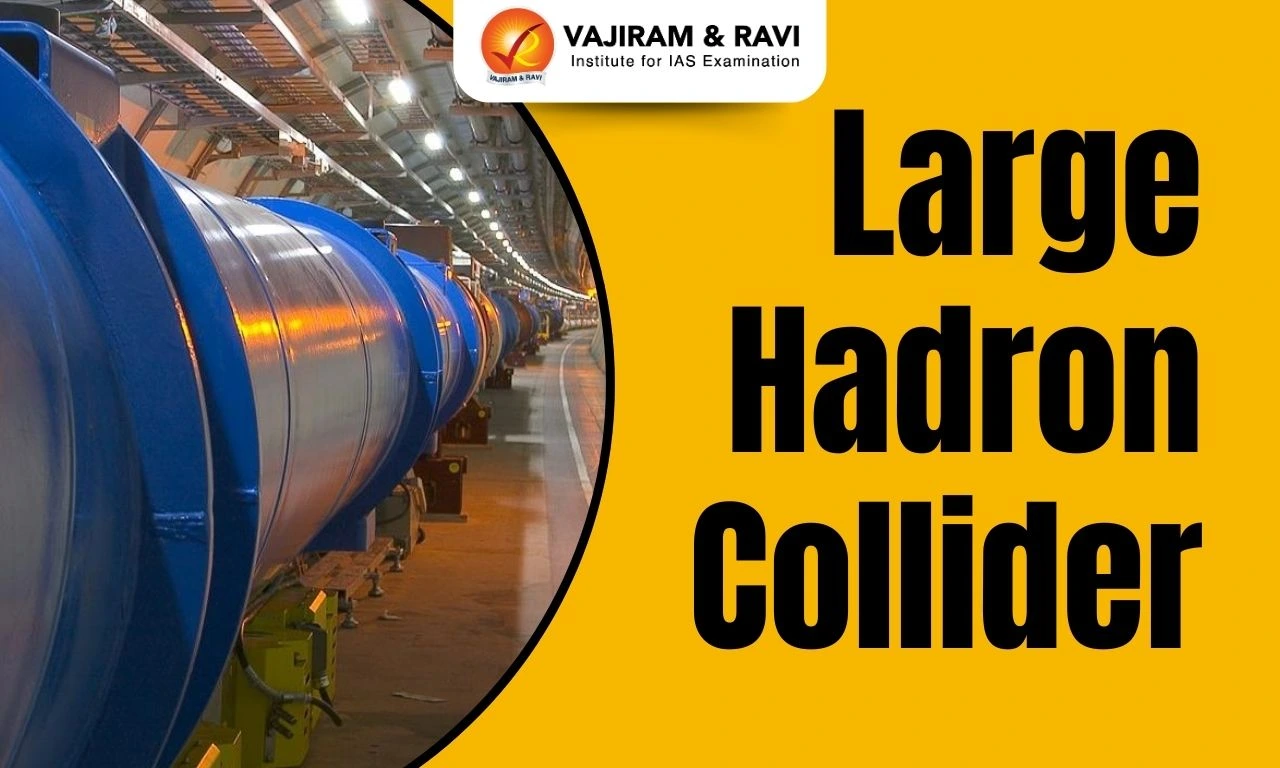The Large Hadron Collider (LHC) is the world’s largest and most powerful particle accelerator built to study fundamental particles, the smallest known building blocks of matter. It is a part of the European Organization for Nuclear Research (CERN)’s accelerator complex. It accelerates two separate beams of particles in opposite directions and makes them collide to create more fundamental particles.
The Large Hadron Collider typically uses protons, the hadrons which are the composite particles made up of smaller particles such as quarks and gluons.
Working Mechanism of Large Hadron Collider
The aim of the Large Hadron Collider is to test theoretical predictions in the Standard Model of particle physics using the collision of hadrons. Currently, physicists are eager to find flaws in the Standard Model because some phenomena, such as dark matter and dark energy, cannot be explained until they are. Following is the working mechanism of the LHC.
- Mechanism:
- The Large Hadron Collider consists of a 27- km ring of superconducting magnets with a number of accelerating structures that boost the energy of the particles.
- Inside the accelerator, the two high-energy particle beams travelling at close to the speed of light (at 99.999999%) are made to collide.
- The beams travel in opposite directions in the separate beam pipes – two tubes kept at ultrahigh vacuum.
- They are guided around the accelerator ring by a strong magnetic field maintained by superconducting magnets.
- The electromagnets that operate in a superconducting state, require chilling ‑271.3°C using liquid helium so that they can conduct electricity without resistance or loss of energy.
- All the controls for the accelerator and technical infrastructure are housed under the CERN Control Centre.
- From here, the beams inside the LHC are made to collide at 4 locations around the accelerator ring, corresponding to four particle detectors – ATLAS, CMS, ALICE and LHCb.
- Particles are smashed together with such enormous energies that the collisions create a cascade of new particles, most of them extremely short-lived.
- The paths of the particles inside the detector are controlled by a gigantic electromagnet called a solenoid.
Experiments and their Findings
There have been ground-breaking experiments at LHC. Some of the successful experiments are as follows:
- Discovery of pion: A rare pion decay was discovered in 1958 during an experiment at the Synchrocyclotron.
- Weak neutral current: The Gargamelle bubble chamber provided the first direct evidence of the weak neutral current in 1973.
- Large Electron-Positron Collider: Since 1989, the LEP has allowed many experiments to provide strong experimental support for the Standard Model of particle physics.
- In 2000, LEP made way for the construction of the LHC in the same tunnel.
- ATLAS: It investigates a wide range of physics, from the Higgs boson to extra dimensions and particles that could make up dark matter.
- Beams of particles from the LHC collide at the ATLAS detector’s centre, creating collision debris in the form of new particles that fly out from the collision point in all directions.
- Compact Muon Solenoid (CMS): It has a broad physics programme ranging from studying the Standard Model (including the Higgs boson) to searching for extra dimensions and particles that could make up dark matter.
- Discovery of Higgs Boson (2012): It is the most important discovery of the Large Hadron Collider experiments, found by the ATLAS and CMS detectors. The Higgs Boson is the reason for having mass in all normal matter.
- ALICE (A Large Ion Collider Experiment): It is a detector dedicated to heavy-ion physics at the LHC. Its purpose is to investigate the physics of strongly interacting matter at high energy densities, where a phase of matter known as quark-gluon plasma forms.
- LHCb (Large Hadron Collider beauty experiment): It specialises in investigating the slight differences between matter and antimatter by studying a type of particle called the “beauty quark”, or “b quark”.
- Experiments to study neutrinos: FASER and SND@LHC, the two newest LHC experiments, are situated close to the ATLAS collision point to search for light new particles and to study neutrinos.
Upgrades in Large Hadron Collider
- Run 1: During the first run of the LHC in 2012, CERN scientists announced the discovery of the Higgs boson, also known as the “God Particle.”.
- Run 2: The second run of the Large Hadron Collider began in 2015 and lasted until 2018. The second season of data-taking produced five times more data than Run 1.
- Run 3: It started in 2023 and will run continuously for four years at unprecedented energy levels of 13 tera electron volts.
- For the ATLAS and CMS experiments, it aims to deliver “1.6 billion proton-proton collisions per second.”
- To increase the collision rate, the proton beams will be narrowed to less than 10 microns (human hair is around 70 microns thick).
India and Large Hadron Collider
India is playing a significant role and could play an even larger role in the upgrade of the Large Hadron Collider.
- History of CERN-India Collaboration:
- DAE and CERN signed an agreement of cooperation in 1991.
- CERN launched its most expensive LHC project and a protocol was signed in 1996 between DAE and CERN.
- India was accorded the ‘Observer status by the CERN Governing Council in 2002.
- India became an Associate Member of CERN in 2016.
- Contribution to ALICE Experiment: Indian groups have built a Photon Multiplicity Detector (PMD) and also a special chip for the Forward Muon Spectrometer, called the MANAS chip.
- Contribution to CMS:
- India contributed the Hadron Barrel Outer Calorimeter (HO-B) and the Silicon Strip-based Pre-shower Detector (PSD).
- The members of the Indian collaboration have also been assigned CMS-wide coordination roles.
- Construction of the Large Hadron Collider (LHC): Indian scientists have been involved in the design of many components of the LHC like superconducting corrector magnets, accelerator protection systems, and cryogenic systems.
- Significance for India: India’s engagements at CERN and LHC have made India arrive on the global mega-science scene.
- Since effective participation in LHC, several international consortia have approached India for participation. India is now participating in the FAIR (Facility for Antiproton and Ion Research) project in Germany, the TMT (Thirty Meter Telescope (TMT) project in the USA, and so on.
- At the national level also, engagement with LHC has led to increased collaboration among institutions in the country.
Significance of Large Hadron Collider
The groundbreaking experiments at Large Hadron Collider have made important contributions to particle physics. The following are the significance of the LHC:
- Higgs boson: One of the most significant discoveries made with the LHC includes the long-sought-after Higgs boson.
- Quark-gluon plasma: Heavy-ion collisions at the Large Hadron Collider will provide a window onto the state of matter that existed in the early universe, called ‘quark-gluon plasma’.
- Supersymmetry: Testing of theories of supersymmetry was an extension of the Standard Model that would fill in some gaps and could pave the way towards a unifying theory, popularly known as the Theory of Everything.
- Matter and Antimatter: One of the most promising ways to shed light on the emergence of matter-antimatter asymmetry in the early universe is to investigate CP violation (matter and antimatter) in beauty-containing particles.
- Data used to analyse patterns: Every year, the detectors produce 30,000 TB of data that is worth storing, and even more in total. Physicists sift through it using computers to identify and analyse specific patterns
Last updated on July, 2025
→ UPSC Notification 2025 was released on 22nd January 2025.
→ UPSC Prelims Result 2025 is out now for the CSE held on 25 May 2025.
→ UPSC Prelims Question Paper 2025 and Unofficial Prelims Answer Key 2025 are available now.
→ UPSC Calendar 2026 is released on 15th May, 2025.
→ The UPSC Vacancy 2025 were released 1129, out of which 979 were for UPSC CSE and remaining 150 are for UPSC IFoS.
→ UPSC Mains 2025 will be conducted on 22nd August 2025.
→ UPSC Prelims 2026 will be conducted on 24th May, 2026 & UPSC Mains 2026 will be conducted on 21st August 2026.
→ The UPSC Selection Process is of 3 stages-Prelims, Mains and Interview.
→ UPSC Result 2024 is released with latest UPSC Marksheet 2024. Check Now!
→ UPSC Toppers List 2024 is released now. Shakti Dubey is UPSC AIR 1 2024 Topper.
→ Also check Best IAS Coaching in Delhi
Tags: large hadron collider quest















